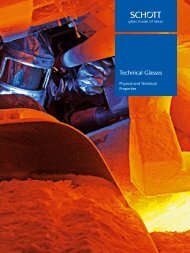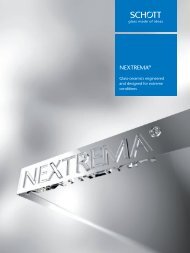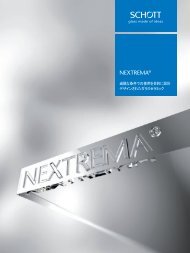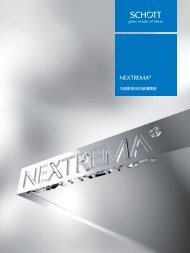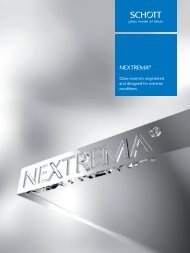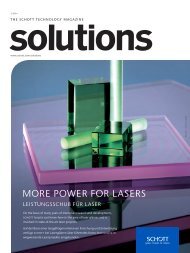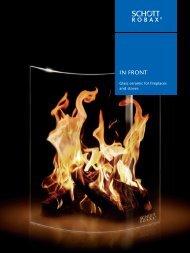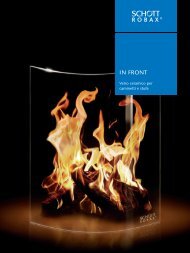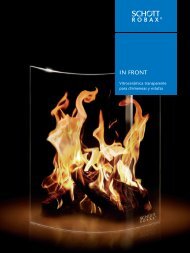Technology Magazine "SCHOTT solutions" - Edition 2/2013 - Technologie Magazin "SCHOTT solutions"
A variety of SCHOTT innovations The latest issue of our technology magazine “solutions” discusses innovations our SCHOTT experts are developing, how they provide support for our customers as partners and how they are addressing tomorrow’s challenges today. Our broad range of products and materials opens up a wide variety of different topics ranging from the universe all the way to the nano cosmos. We wish you enjoyable reading! Spannende Stories über SCHOTT Innovationen Die neuste Ausgabe des Technologiemagazins „solutions“ verrät, was SCHOTT Experten entwickeln, wie sie Anwendern kompetenter Partner sind und die Herausforderungen von morgen schon heute anpacken. Unsere breite Produkt- und Materialpalette erschließt dabei ein weites Feld: vom Weltall bis in den Nanokosmos. Viel Spaß beim Lesen!
A variety of SCHOTT innovations
The latest issue of our technology magazine “solutions” discusses innovations our SCHOTT experts are developing, how they provide support for our customers as partners and how they are addressing tomorrow’s challenges today. Our broad range of products and materials opens up a wide variety of different topics ranging from the universe all the way to the nano cosmos. We wish you enjoyable reading!
Spannende Stories über SCHOTT Innovationen
Die neuste Ausgabe des Technologiemagazins „solutions“ verrät, was SCHOTT Experten entwickeln, wie sie Anwendern kompetenter Partner sind und die Herausforderungen von morgen schon heute anpacken. Unsere breite Produkt- und Materialpalette erschließt dabei ein weites Feld: vom Weltall bis in den Nanokosmos. Viel Spaß beim Lesen!
Create successful ePaper yourself
Turn your PDF publications into a flip-book with our unique Google optimized e-Paper software.
layer and ultimately the entire glass-to-metal compound. In<br />
addition, we are able to detect defects more accurately and more<br />
quickly for internal and external customers. We are able to answer<br />
questions such as, ,What caused the system to fail?, Now, we have<br />
just the right magnifying glass we need to do this type of detective<br />
work,” Dr. Kuhr notes.<br />
In fact, this high-performance tool even sees things that<br />
<strong>SCHOTT</strong> could never see before. For example, the multicomponent<br />
nano structure of the cermet layer can now be displayed. This<br />
absorber layer absorbs the radiation from the sun in the receivers<br />
used in solar power plants. It contains extremely small metal particles<br />
that increase efficiency, but would be too small to be used for<br />
display purposes with the devices previously available. “Now, we<br />
are able to optimize these particles and thus further increase the<br />
efficiency of the receiver,” Dr. Corvers explains. This instrument<br />
also provides more reliable results than other techniques because<br />
sometimes the sample has to be destroyed to allow for target<br />
preparation of extremely small defects. Small porous particles only<br />
10 micrometers in size that initially only occur as colored points<br />
and lie under the surface of a glass or glass-ceramic are only one<br />
example. This type of defect is extremely difficult to detect.<br />
Grinding or polishing is usually either too risky or impossible.<br />
FIB characterization, however, increases the probability of deriving<br />
useful analytical results. “And the possibilities an electron microscope<br />
offers are far from being exhausted,” Dr. Kuhr notes. <<br />
markus.kuhr@schott.com<br />
stephan.corvers@schott.com<br />
drang Feuchtigkeit, was dann zur Zersetzung des Glases führte.<br />
„Solche Aufschlüsse erlauben es uns zum einen, Aufbau, Haftung<br />
oder chemische Beständigkeit der Schicht zu optimieren und letztlich<br />
den gesamten Glas-Metall-Verbund zu verbessern. Zum anderen<br />
können wir für interne und externe Kunden nun viel<br />
besser und schneller Defekte aufspüren und Fragen beantworten<br />
wie: Warum versagt ein System? Wir haben jetzt die richtige Lupe<br />
für diese Detektivarbeit“, beschreibt Dr. Kuhr.<br />
Dabei sieht das leistungsstarke Werkzeug Dinge, die vorher<br />
für <strong>SCHOTT</strong> nicht sichtbar waren. Mit seiner Hilfe gelang es erstmals,<br />
die mehrkomponentige Nanostruktur der sogenannten<br />
Cermet-Schicht abzubilden. Diese Absorber-Schicht nimmt in<br />
Receivern von Solarkraftwerken die Strahlung der Sonne auf. Sie<br />
enthält winzigste Metallpartikel, die den Wirkungsgrad erhöhen,<br />
aber für eine Darstellung mit bisherigen Mitteln zu klein waren.<br />
„Nun können wir die Partikel optimieren und somit die Effizienz<br />
des Receivers weiter steigern“, so Dr. Corvers. Das Instrument liefert<br />
außerdem zuverlässiger Resultate als andere Verfahren. Denn<br />
zur Zielpräparation winzigster Defekte gilt es manchmal die Probe<br />
zu zerstören. Ein Beispiel hierfür sind 10 Mikrometer kleine poröse<br />
Partikel, die zunächst nur als verfärbte Punkte in Erscheinung<br />
traten und unter der Oberfläche von Glas oder Glaskeramik lagen.<br />
Ein solcher Defekt ist sehr schwierig freizulegen; Schleifen oder<br />
Polieren ist hier meist zu riskant oder unmöglich. Eine FIB-<br />
Charakterisierung dagegen bietet eine hohe Sicherheit, ein verwertbares<br />
Analyse-Ergebnis zu bekommen. „Und damit sind die<br />
Möglichkeiten des Elektronenmikroskops noch längst nicht ausgeschöpft“,<br />
verrät Dr. Kuhr. <<br />
markus.kuhr@schott.com<br />
stephan.corvers@schott.com<br />
Photo Foto : <strong>SCHOTT</strong>/ C. Costard<br />
The ion beam optics FIB (Focused Ion Beam) of the Neon can often<br />
do very quickly what conventional preparation methods either can't do<br />
at all or take much longer to do.<br />
Wofür übliche Präparationsmethoden viel Zeit brauchen oder nicht anwendbar<br />
sind, gelingt mit der Ionenstrahloptik FIB (Focused Ion Beam)<br />
des Neon oft in kurzer Zeit oder wird überhaupt erst möglich.<br />
13






